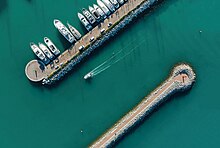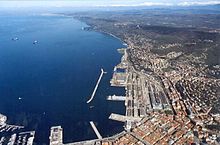Port
A port is a
Ports are extremely important to the global economy; 70% of global merchandise trade by value passes through a port.
Ports can have a wide environmental impact on local ecologies and waterways, most importantly water quality, which can be caused by dredging, spills and other pollution. Ports are heavily affected by changing environmental factors caused by climate change as most port infrastructure is extremely vulnerable to sea level rise and coastal flooding.[3] Internationally, global ports are beginning to identify ways to improve coastal management practices and integrate climate change adaptation practices into their construction.[3]
Historical ports
Wherever ancient civilisations engaged in maritime trade, they tended to develop sea ports. One of the world's oldest known artificial harbors is at Wadi al-Jarf on the Red Sea.[5] Along with the finding of harbor structures, ancient anchors have also been found.
Other ancient ports include
Post-classical Swahili kingdoms are known to have had trade port islands and trade routes[7] with the Islamic world and Asia. They were described by Greek historians as "metropolises".[8] Famous African trade ports such as Mombasa, Zanzibar, Mogadishu and Kilwa[9] were known to Chinese sailors such as Zheng He and medieval Islamic historians such as the Berber Islamic voyager Abu Abdullah ibn Battuta.[10]
Many of these ancient sites no longer exist or function as modern ports. Even in more recent times, ports sometimes fall out of use. Rye, East Sussex, was an important English port in the Middle Ages, but the coastline changed and it is now 2 miles (3.2 km) from the sea, while the ports of Ravenspurn and Dunwich have been lost to coastal erosion.
Modern ports

Whereas early ports tended to be just simple harbours, modern ports tend to be multimodal distribution hubs, with transport links using sea, river, canal, road, rail and air routes. Successful ports are located to optimize access to an active hinterland, such as the London Gateway. Ideally, a port will grant easy navigation to ships, and will give shelter from wind and waves. Ports are often on estuaries, where the water may be shallow and may need regular dredging. Deep water ports such as Milford Haven are less common, but can handle larger ships with a greater draft, such as super tankers, Post-Panamax vessels and large container ships. Other businesses such as regional distribution centres, warehouses and freight-forwarders, canneries and other processing facilities find it advantageous to be located within a port or nearby. Modern ports will have specialised cargo-handling equipment, such as gantry cranes, reach stackers and forklift trucks.
Ports usually have specialised functions: some tend to cater mainly for
In modern times, ports survive or decline, depending on current economic trends. In the UK, both the ports of
In mainland Europe, it is normal for ports to be publicly owned, so that, for instance, the ports of Rotterdam and Amsterdam are owned partly by the state and partly by the cities themselves.[12]
Even though modern ships tend to have bow-thrusters and stern-thrusters,[citation needed] many port authorities still require vessels to use pilots and tugboats for manoeuvering large ships in tight quarters. For instance, ships approaching the Belgian port of Antwerp, an inland port on the River Scheldt, are obliged to use Dutch pilots when navigating on that part of the estuary that belongs to the Netherlands.
Ports with international traffic have customs facilities.
Types
This section needs additional citations for verification. (December 2012) |
The terms "port" and "seaport" are used for different types of facilities handling ocean-going vessels, and river port is used for river traffic, such as barges and other shallow-draft vessels.
Inland port
An inland port is a port on a navigable lake, river (
.Seaport
A seaport is a port located on the shore of a sea or ocean. It is further categorized as commercial and non-commercial: [14]
- Commercial ones includes "cargo ports". Additionally, "cruise ports" are also known as a "home port" or a "port of call"; and "cargo port" is also further categorized into a "bulk" or "break bulk port" or as a "container port".
- Non-commercial seaports are fishing ports.
Cargo port
Cargo ports are quite different from cruise ports, because each handles very different cargo, which has to be loaded and unloaded by a variety of mechanical means.
Bulk cargo ports may handle one particular type of cargo or numerous cargoes, such as grains, liquid fuels, liquid chemicals, wood, automobiles, etc. Such ports are known as the "bulk" or "break bulk ports".
Ports that handle containerized cargo are known as container ports.
Most cargo ports handle all sorts of cargo, but some ports are very specific as to what cargo they handle. Additionally, individual cargo ports may be divided into different operating terminals which handle the different types of cargoes, and may be operated by different companies, also known as terminal operators, or
Cruise port
A cruise home port is the port where cruise ship passengers board (or
Port of call
A port of call is an intermediate stop for a ship on its sailing itinerary. At these ports, cargo ships may take on supplies or fuel, as well as unloading and loading cargo while cruise liners have passengers get on or off ship.
Fishing port
A fishing port is a port or harbor for landing and distributing fish. It may be a recreational facility, but it is usually commercial. A fishing port is the only port that depends on an ocean product, and depletion of fish may cause a fishing port to be uneconomical.
Marina

A marina is a port for recreational boating.
Warm-water port
A warm-water port (also known as an ice-free port) is one where the water does not freeze in winter. This is mainly used in the context of countries with mostly cold winters where parts of the coastline freezes over every winter. Because they are available year-round, warm-water ports can be of great geopolitical or economic interest. Such settlements as
Dry port
A dry port is an inland intermodal terminal directly connected by road or rail to a seaport and operating as a centre for the transshipment of sea cargo to inland destinations.[17]
Smart port
A smart port uses technologies, including the Internet of Things (IoT) and artificial intelligence (AI) to be more efficient at handling goods.[18] Smart ports usually deploy cloud-based software as part of the process of greater automation to help generate the operating flow that helps the port work smoothly.[19] At present, most of the world's ports have somewhat embedded technology, if not for full leadership. However, thanks to global government initiatives and exponential growth in maritime trade, the amount of intelligent ports has gradually increased. This latest report by business intelligence provider Visiongain assesses that Smart Ports Market spending will reach $1.5 bn in 2019.[20]
Environmental issues
Environmental impact of shipping
Ports and their operation are often a cause of environmental issues, such as sediment contamination and spills from ships and are susceptible to larger environmental issues, such as human caused climate change and its effects.[21] DredgingEvery year 100 million cubic metres of marine sediment are dredged to improve waterways around ports. Dredging, in its practice, disturbs local ecosystems, brings sediments into the water column, and can stir up pollutants captured in the sediments.[21] Invasive speciesbilge water and species attached to the hulls of ships.[21] It is estimated that there are over 7000 invasive species transported in bilge water around the world on a daily basis[22] Invasive species can have direct or in-direct interactions with native sea life. Direct interaction such as predation, is when a native species with no natural predator is all of a sudden prey of an invasive specie. In-direct interaction can be diseases or other health conditions brought by invasive species. [23]
 Air pollutionPorts are also a source of increased air pollution as a result of ships and land transportation at the port. Transportation corridors around ports have higher exhaust emissions and this can have related health effects on local communities.[21] Water qualityWater quality around ports is often lower because of both direct and indirect pollution from the shipping, and other challenges caused by the port's community, such as trash washing into the ocean.[21] Spills, pollution and contaminationSewage from ships, and leaks of oil and chemicals from shipping vessels can contaminate local water, and cause other effects like nutrient pollution in the water.[21] Climate change and sea level risePorts and their infrastructure are very vulnerable to climate change and sea level rise, because many of them are in low-lying areas designed for status quo water levels.[3] Variable weather, coastal erosion, and sea level rise all put pressure on existing infrastructure, resulting in subsidence, coastal flooding and other direct pressures on the port.[3] Reducing impactThere are several initiatives to decrease negative environmental impacts of ports.[24][25][26] The World Port Sustainability Program points to all of the Sustainable Development Goals as potential ways of addressing port sustainability.[27] These include SIMPYC, the World Ports Climate Initiative, the African Green Port Initiative, EcoPorts and Green Marine.[26][28] World's major portsAfrica
Asia The cargo tonnage and activity. It regained its position as the world's busiest port by cargo tonnage and the world's busiest container port in 2009 and 2010, respectively. It is followed by the ports of Singapore, Hong Kong and Kaohsiung, Taiwan, all of which are in East and Southeast Asia .
The port of Singapore is the world's second-busiest port in terms of total shipping tonnage, it also crude oil, and is the world's busiest transshipment port .
Europe Europe's busiest container port and biggest port by cargo tonnage by far is the Port of Rotterdam, in the Netherlands. It is followed by the Belgian Port of Antwerp or the German Port of Hamburg, depending on which metric is used.[29] In turn, the Spanish Port of Valencia is the busiest port in the Mediterranean basin, while the Portuguese Port of Sines is the busiest atlantic port. The Port of Trieste, Italy, is the main port of the northern Adriatic and starting point of the Transalpine Pipeline. North AmericaThe largest ports include the that connects the Pacific and Atlantic Ocean, and is a key conduit for international trade.OceaniaThe largest port in Oceania is the Port of Melbourne. South AmericaAccording to ECLAC's "Maritime and Logistics Profile of Latin America and the Caribbean", the largest ports in South America are the Port of Santos in Brazil, Cartagena in Colombia, Callao in Peru, Guayaquil in Ecuador, and the Port of Buenos Aires in Argentina.[30] See also
Other logistics hubsListsReferences
External linksWikimedia Commons has media related to Ports and harbours.
|
